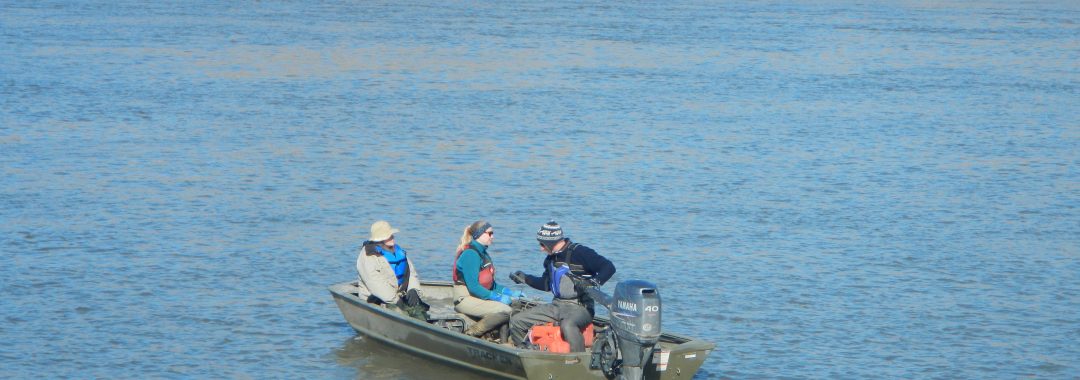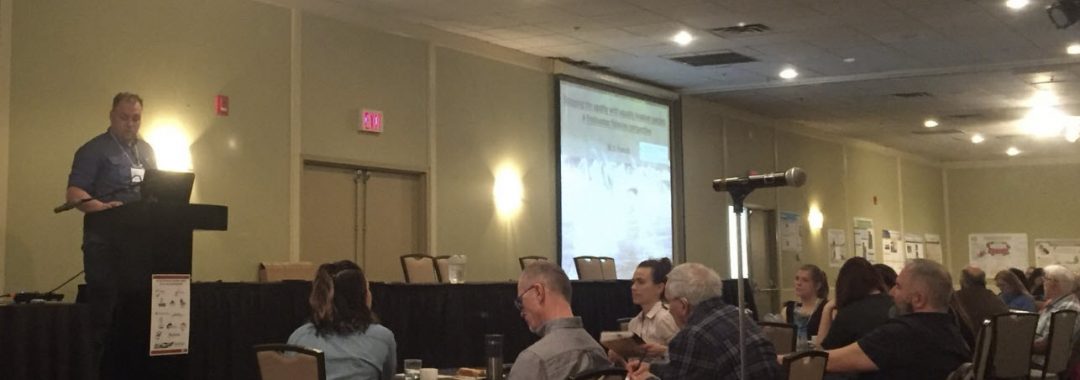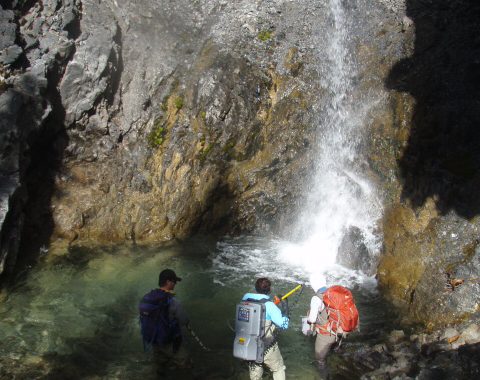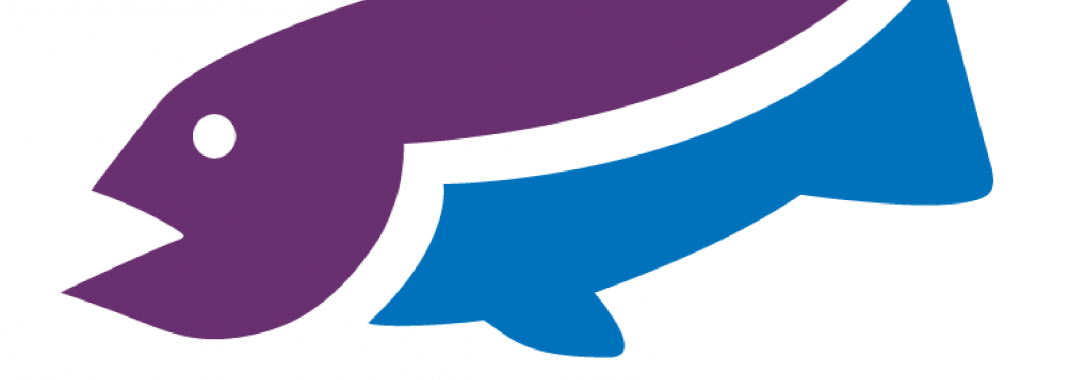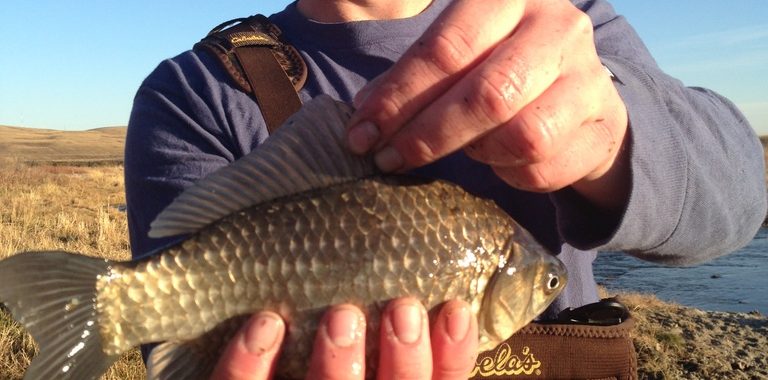The PoeschLab is excited to join the Canadian Freshwater Species at Risk Network (link). Thanks to Fisheries and Oceans Canada for their funding support for fish species at risk.
Category Archives: Mark Poesch
My research focuses on issues related to aquatic biodiversity, including: conservation of freshwater fishes (e.g. species at risk, invasive species), sustainable resource development and developing robust restoration and reclamation activities. My goals are to: build effective collaborations across Alberta and North America; to train the next generation of research leaders; to provide an atmosphere of respect and learning; to engage the public and stakeholders; and, to develop leading edge novel research to solve applied problems.
Ruppert, J.L.W.*, Hogg, J., and M.S. Poesch. (2018) Community assembly and the sustainability of habitat offsetting targets in the first compensation lake in the oil sands region in Alberta, Canada. Biological Conservation 219: 138-146.
Abstract:
Resource development can have a negative impact on species productivity and diversity through the loss and fragmentation of habitat. In many countries, developers are required by law to offset such impacts by replacing lost habitat or providing other forms of compensation. In the case of broad scale development, offsets often cannot be constructed to replace lost habitat “like-for-like” (i.e., they are not ecologically equivalent). In freshwater ecosystems, one approach to habitat offsetting is to create new lake ecosystems, called compensation lakes, to replace lost riverine habitat. In this study, we use a long-term data set (2008–2015) of fish and benthic invertebrate communities from Canada’s first compensation lake in the oil sands region of Alberta, to address (1) whether the assembly of the fish community has a trajectory that is influenced by management activities and (2) determine whether the community composition in the habitat offset is common in natural lake ecosystems within the region. We find a significant decline in the mean trophic level of the lake, where 61.9% of the variation in trophic level is explained by time indicating a strong structuring influence on fish communities. This outcome has enabled the compensation lake to meet overall and single species productivity targets, but we find that the species assemblage and composition is not common within the region. A combination of the founding species community and reduced connectivity of the lake has contributed to the current fish community structure, which may be problematic for the sustainability of the habitat offsetting targets. Our study highlights the need to establish multiple conservation guidelines, using both productivity and diversity based metrics, to provide the best ecological equivalency, which can produce better function, resilience and health within focal species communities in habitat offsets that are not “like-for-like.”
Citation: Ruppert, J.L.W., Hogg, J., and M.S. Poesch. (2018) Community assembly and the sustainability of habitat offsetting targets in the first compensation lake in the oil sands region in Alberta, Canada. Biological Conservation 219: 138-146.
Graphical Abstract:

Figure – Changes in Freshwater Communities Through Time. Shown is teh annual (A) mean density and (B) species diversity of fish species in Horizon Lake during the monitoring period of 2008-2015. Also shown is the corresponding annual (C) mean density and (D) diversity of bentic invertebrates during that period (EK- Ekman Grab; KN – Kick Net).
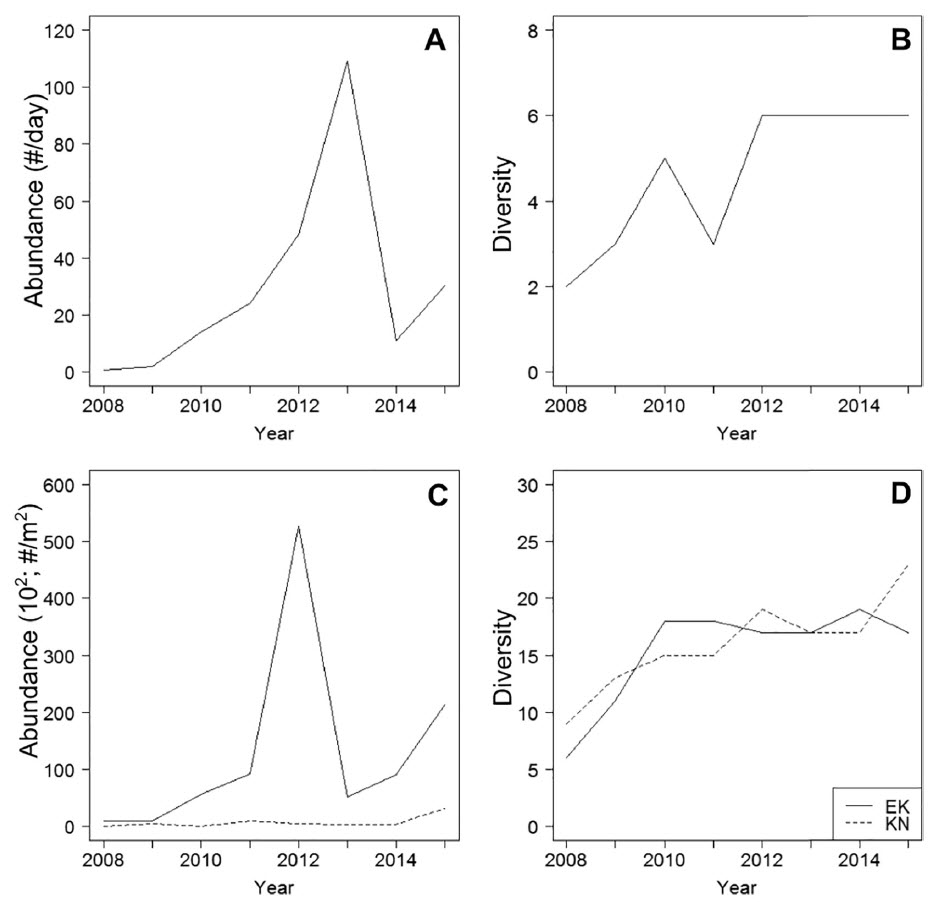
Also Read:
*Lab members: Jonathan Ruppert, Mark Poesch. Check out opportunities in the lab!
Dr. Poesch gives plenary talk and participates on expert panel on invasive species
It was a great honour to give a plenary talk on freshwater invasive species and participate in a panel discussion with Dr. Daniel Simberloff (University of Tennessee), Dr. Chris Thomas (University of York, UK), Jason Fisher and Margo Pybus at this year’s Alberta Wildlife Society meeting in Lethbridge. I really enjoyed the discussion on invasive species! I was also very impressed to see as many as five undergraduate students from my Fish and Wildlife class in attendance! Also happy to see my students Sebastian Theis (PhD candidate), Jesse Shirton (undergraduate) and Jamie Card (undergraduate) present posters on their research!
Neufeld, K.*, Watkinson, D., Tierney, K. and M.S. Poesch. (2018) Incorporating connectivity in measures of habitat suitability to assess impacts of hydrologic alteration to stream fish. Diversity and Distributions 24: 593-604.
Abstract
Hydrologic alterations are widespread in freshwater ecosystems worldwide and often detrimentally impact fish populations. Habitat suitability models are commonly used to assess these impacts, but these models frequently rely upon observed fish–habitat relationships rather than more mechanistic underpinnings. The aim of this study was to demonstrate how to incorporate swim performance into a measure of habitat connectivity at a fine scale, providing a method for assessing the availability of suitable habitat for stream fishes. We applied this technique to an endangered species, the Western Silvery Minnow Hybognathus argyritis, in the Milk River of southern Alberta, Canada. The Milk River is an augmented system, where a diversion in nearby St. Mary River augments flow by a factor >3 × (from 1–5 m3/s to 15–20 m3/s). We used laboratory measured swim performance of Western Silvery Minnow to develop a movement cost function that was used in conjunction with a habitat suitability model to assess habitat availability via a recently developed graph-theoretic metric, equivalent connected area (ECA). Stream augmentation altered not only habitat suitability but also habitat connectivity for this species. During augmentation, suitable habitat area declined by 81.3%. Changes in habitat connectivity were site dependent. Movement costs between habitat patches were lower during augmentation due to current-assisted dispersal and increased distance to patches during natural flows from dried streambeds. When movement costs were incorporated into ECA, ECA decreased by 78.0% during augmentation.With changing climate and increasing anthropogenic impacts on aquatic ecosystems, understanding how freshwater fishes relate to their habitat is critical for appropriate management. In many cases, such as the Western Silvery Minnow, mitigating habitat suitability may not be sufficient, as species are unable to reach suitable habitat. The incorporation of swim performance into habitat connectivity assessments, as carried out here, can be easily adapted to other species and situations and can improve the understanding of impacts to stream fishes and increase the effectiveness of mitigation efforts.
Citation: Neufeld, K.*, Watkinson, D., Tierney, K. and M.S. Poesch. (2018) Incorporating connectivity in measures of habitat suitability to assess impacts of hydrologic alteration to stream fish. Diversity and Distributions 24: 593-604.
Movement Cost of Western Silvery Minnow under Augment (top) and Natural (bottom) Flow Conditions

Also Read:
*Lab members: Kenton Neufeld, Mark Poesch. Check out opportunities in the lab!
Rudolfsen, T.*, Watkinson, D. and Poesch, M.S. (2018) Morphological divergence of the Threatened Rocky Mountain sculpin (Cottus sp.) is driven by biogeography and flow regime. Aquatic Conservation: Marine and Freshwater Ecosystems 28: 78-86.
Abstract
Stream hydrology is considered the primary factor in structuring freshwater fish communities,influencing stream habitats, food resources, and life‐history characteristics. Changes in stream hydrology, from climate change and anthropogenic sources (e.g. dams, irrigation channels), are thought to have adverse impacts on many freshwater species. The Rocky Mountain Sculpin (Cottus sp.) is a threatened species in Canada. Phenotypes of Rocky Mountain Sculpin were compared across a gradient of four streams differing in stream hydrology. It was hypothesized that Rocky Mountain Sculpin would show body forms minimizing drag in higher flow environments. Using geometric morphometrics and meristic counts, body shape, fin rays, and sensory pores were compared. As hypothesized, high‐flow river systems were correlated with sculpin with more dorso‐ventrally compressed, slender body shapes that minimized resistance to flow (P<0.001). Rocky Mountain Sculpin had more pectoral fin rays in populations with higher flows than lower flows,potentially allowing them to increase friction when gripping onto the substrate (P<0.001), and more anteriorly and dorsally located head pores to improve detection of floating prey (P<0.001). Biogeographic isolation and difference in flow regime were the likely basis for the observed morphological variation. The degree to which these phenotypes become fixed is unknown;however, since phenotypic diversity parallels genetic diversity in Rocky Mountain Sculpin,there is the possibility that persistent selection of these phenotypes can make it difficult to adapt to rapidly changing habitat conditions, such as changing flow. This study emphasizes the importance of considering phenotypic and morphological variation when evaluating how best to mitigate anthropogenic stressors and their impact on freshwater fishes.
Citation: Rudolfsen, T.*, Watkinson, D. and Poesch, M.S. (2018) Morphological divergence of the Threatened Rocky Mountain sculpin (Cottus sp.) is driven by biogeography and flow regime. Aquatic Conservation: Marine and Freshwater Ecosystems 28: 78-86.
Flow Regime across the range of Rocky Mountain Sculpin
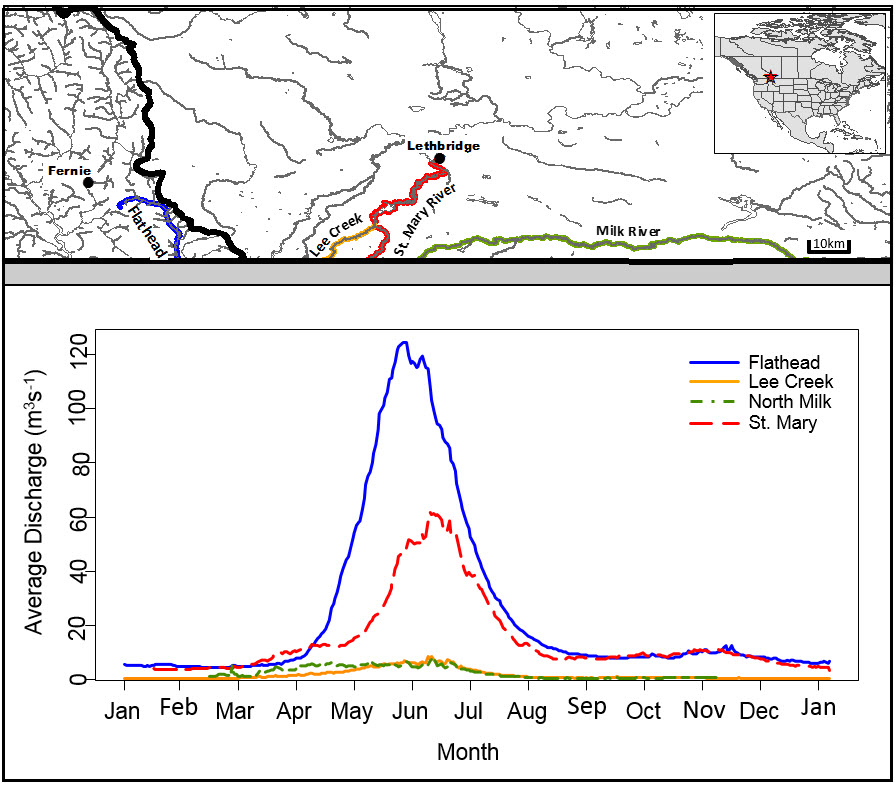
Morphological Differences Across Populations (Dorsal view) of Rocky Mountain Sculpin
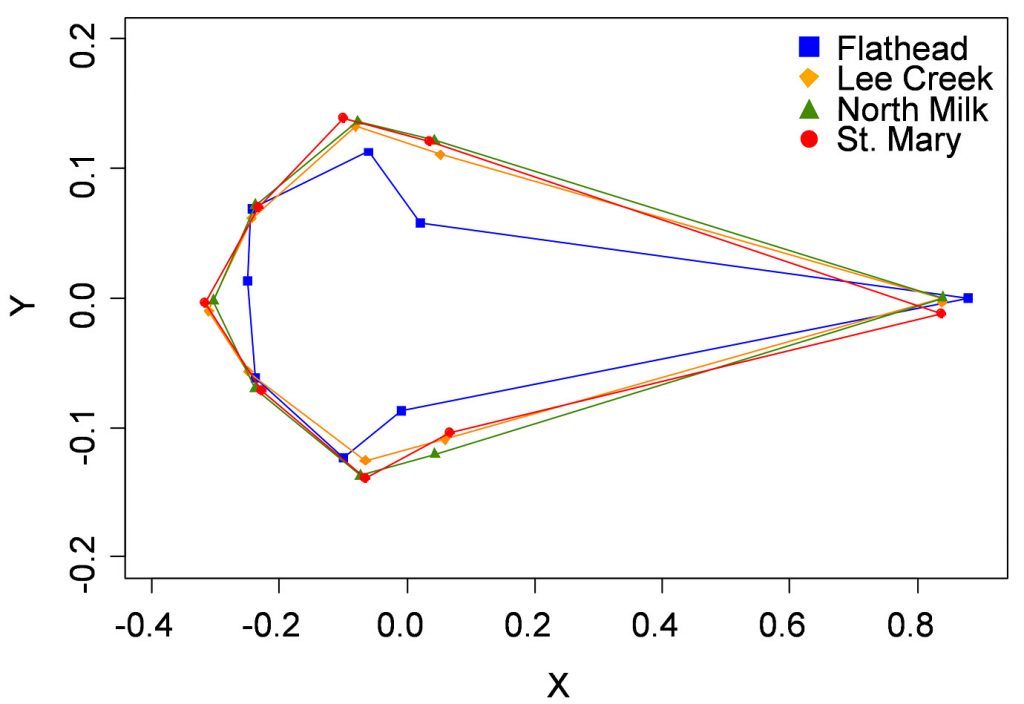
Also Read:
* Lab members: Tyana Rudolfsen, Mark Poesch. Check out opportunities in the lab!
The Fisheries and Aquatic Conservation Lab helps host the Canadian Conference for Fisheries Research (CCFFR)
For the first time in almost 25 years, the Canadian Conference for Fisheries Research returns to Edmonton, AB. With Dr. Poesch as Local Organizing Chair, the PoeschLab was front and centre helping run the show. The PoeschLab also contributed 14 talks or posters to the event! Great job team!
Ruppert, J.L.W.*, Docherty,C.*, Rudolfsen, T.*, Neufeld, K.*, Hamilton, K.*, MacPherson, L. and M.S. Poesch. (2017) Native North American freshwater species get out of the way: Prussian Carp (Carassius gibelio) establishment impacts both fish and macroinvertebrate communities. Royal Society Open Science 4: 170400.
Abstract:
Prussian carp (Carassius gibelio) are one of the most noxious non-native species in Eurasia. Recently, Prussian carp, a nonnative freshwater fish species, were genetically confirmed in Alberta, Canada and have been rapidly expanding their range in North America since establishment. Given their rapid range expansion, there is an increasing need to determine how Prussian carp may impact native species. We assessed the severity of the Prussian carp invasion by (i) determining their impact on fish communities, (ii) assessing their impact on benthic invertebrate communities, (iii) evaluating if Prussian carp alter abiotic conditions, and (iv) identifying where we find higher abundances of Prussian carp. When Prussian carp were established, we found significant changes to the fish community. Correspondingly, the degree of impact to benthic invertebrate communities was related to the stage of invasion (none, early or recent), where changes in fish communities were significantly concordant with changes in benthic invertebrate communities. Finally, we found that higher abundances of Prussian carp were significantly associated with lower abundances of a majority of native fish species. Altogether, using three lines of evidence, we determine that Prussian carp can have wide-ranging impacts on freshwater ecosystems in North America, pressing the need for management intervention.
Citation: Ruppert, J.L.W.*, Docherty,C.*, Rudolfsen, T.*, Neufeld, K.*, Hamilton, K.*, MacPherson, L. and M.S. Poesch. (2017) Native North American freshwater species get out of the way: Prussian Carp (Carassius gibelio) establishment impacts both fish and macroinvertebrate communities. Royal Society Open Science 4: 170400.
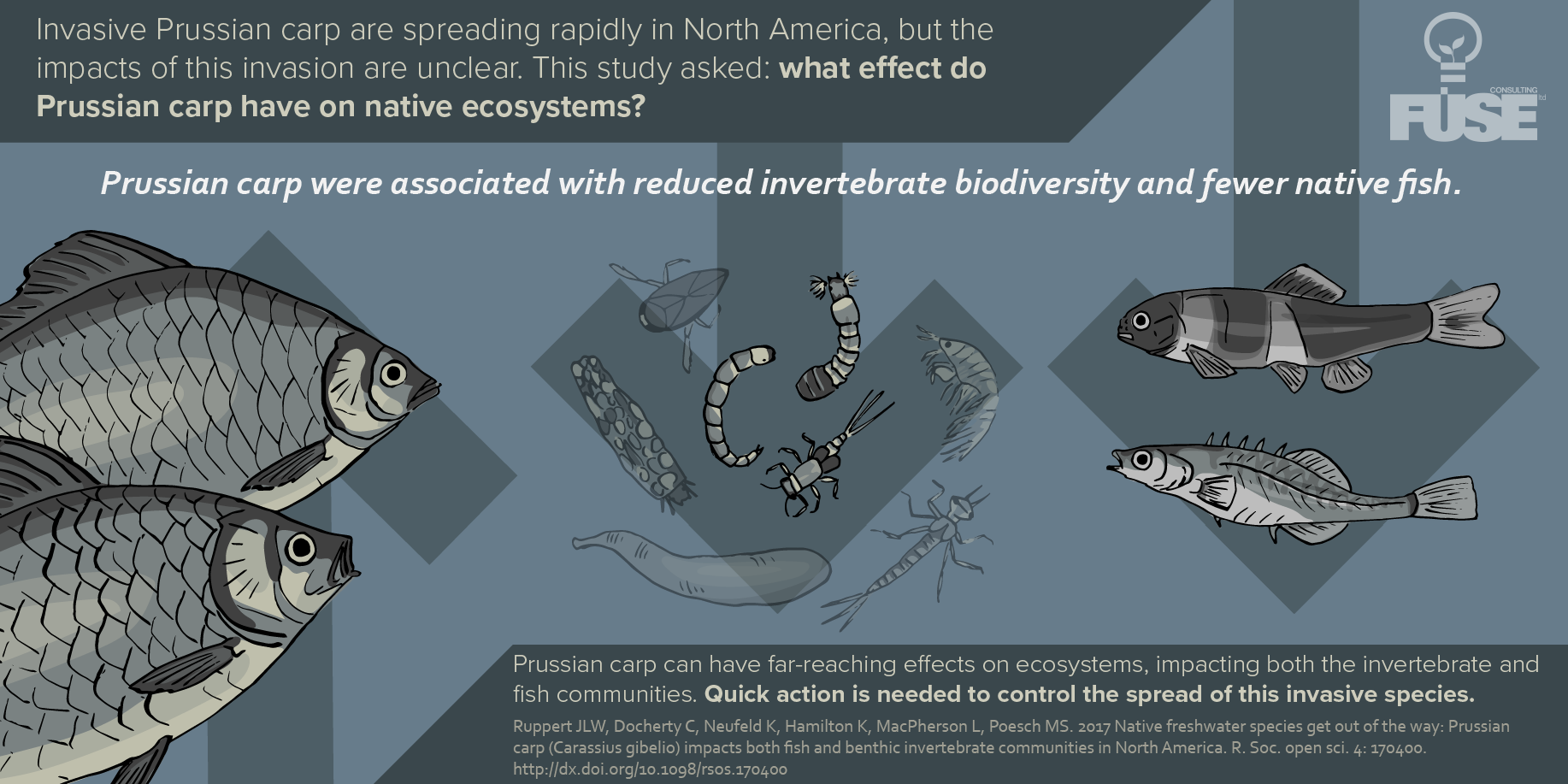
Also Read:
*Lab members: Jonathan Ruppert, Cassandra Docherty, Tyana Rudolfsen, Kenton Neufeld, Kyle Hamilton, Mark Poesch. Check out opportunities in the lab!
Docherty, C.*, Ruppert, J.*, Rudolfsen, T.*, Hamann, A., and Poesch, M.S. (2017) Assessing the spread and potential impact of Prussian Carp (Carassius gibelio Bloch, 1782) to freshwater fishes in western North America. BioInvasions Records 6: 291-296.
Abstract:
Prussian Carp (Carassius gibelio Bloch, 1782) is one of the most successful invasive species in Eurasia. Recently, Prussian Carp were genetically confirmed in Alberta, Canada, documenting the first detection of this species in North America. Given the close morphological similarity to their sister species, the Goldfish (Carassius auratus Linnaeus, 1758), it is likely that this species has been undetected for some time. We document the spread of Prussian Carp since arrival (circa 2000), and contribute a trait-based risk assessment to potential recipient communities in western North America. Using a meta-analysis of geo-referenced fisheries data in conjunction with original sampling in 2014, we show that the Prussian Carp range has increased by eight- to eleven-fold over 15 years in Alberta at a rate of approximately 233–1,250 km2 per year. Range expansions in the near future are possible through the Saskatchewan River drainage and south into the Missouri River basin, with easily accessible routes to Midwestern North America through irrigation canals. We show high life history trait overlap with other successful invasive species, such as Goldfish and Common Carp (Cyprinus carpio Linnaeus, 1758). Additionally, there was high life history trait overlap with several species of native sunfish (Centrarchidae) and suckers (Catostomidae). This study highlights Prussian Carp’s potential to widely impact North American freshwater ecosystems and to successfully compete with native taxa. Considered one of the worst invaders in Eurasia, the arrival of Prussian Carp in North America poses serious concern for fisheries managers. There is an urgent need to develop management plans before further range expansion and disruption of freshwater ecosystems by this new invasive species.
Citation: Docherty, C.*, Ruppert, J.*, Rudolfsen, T.*, Hamann, A., and Poesch, M.S. 2017. Assessing the spread and potential impact of Prussian Carp (Carassius gibelio Bloch, 1782) to freshwater fishes in western North America. BioInvasions Records 6: 291-296.
Spread of Prussian Carp in Alberta, Canada

Also Read:
*Lab members: Cassandra Docherty, Jonathan Ruppert, Tyana Rudolfsen, Mark Poesch. Check out opportunities in the lab!
Sun, C., Shotyk, W., Cuss, C., Donner, M., Fennel, M., Javed, M., Noernberg, T., Poesch, M.S., Pelletier, R., Sinnatamby, N.*, Siddique, T., and J. Martin. (2017) Characterisation of naphthenic acids and bitumen derived organics in natural water from the Athabasca Oil Sands Region, Canada. Environmental Science and Technology 51 (17): 9524-9532
Abstract:
With growth of the Canadian oil sands industry, concerns have been raised about possible seepage of toxic oil sands process-affected water (OSPW) into the Athabasca River (AR). A sampling campaign in fall 2015 was undertaken to monitor for anthropogenic seepage while also considering natural sources. Naphthenic acids (NAs) and thousands of bitumen-derived organics were characterized in surface water, groundwater, and OSPW using a highly sensitive online solid phase extraction-HPLC-Orbitrap method. Elevated NA concentrations and bitumen-derived organics were detected in McLean Creek (30.1 μg/L) and Beaver Creek (190 μg/L), two tributaries that are physically impacted by tailings structures. This was suggestive of OSPW seepage, but conclusive differentiation of anthropogenic and natural sources remained difficult. High NA concentrations and bitumen-derived organics were also observed in natural water located far north of the industry, including exceedingly high concentrations in AR groundwater (A5w-GW, 2000 μg/L) and elevated concentration in a tributary river (Pierre River, 34.7 μg/L). Despite these evidence for both natural and anthropogenic seepage, no evidence of any bitumen-derived organics was detected at any location in AR mainstem surface water. The chemical significance of any bitumen-derived seepage to the AR was therefore minimal, and focused monitoring in tributaries will be valuable in the future.
Citation: Sun, C., Shotyk, W., Cuss, C., Donner, M., Fennel, M., Javed, M., Noernberg, T., Poesch, M.S., Pelletier, R., Sinnatamby, N., Siddique, T., and J. Martin. (2017) Characterisation of naphthenic acids and bitumen derived organics in natural water from the Athabasca Oil Sands Region, Canada. Environmental Science and Technology 51 (17): 9524-9532
Also Read:
*Lab members: Nilo Sinnatamby, Mark Poesch. Check out opportunities in the lab!

